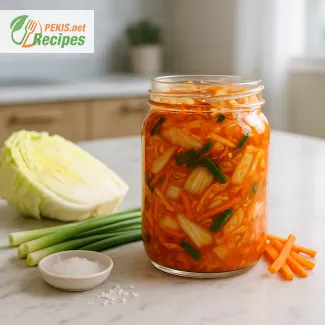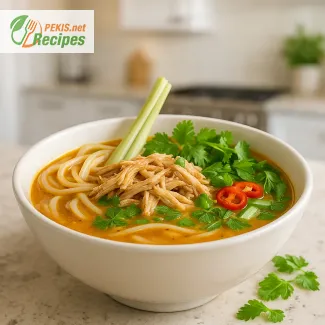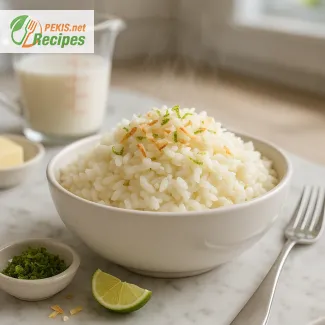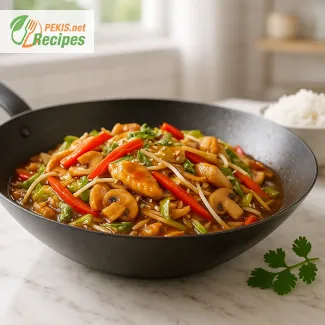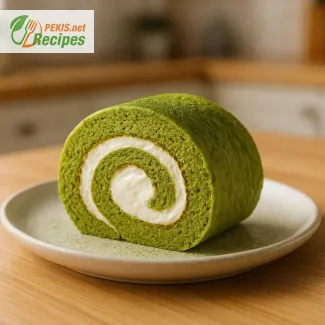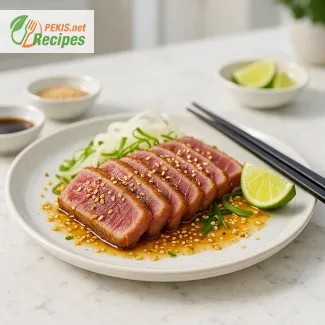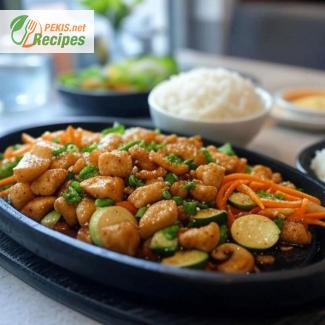
If you're craving a dish that brings the energy and excitement of Japanese-style cooking to your dining table, Classic Hibachi Chicken with Vegetables is the perfect choice. This flavorful and vibrant recipe captures the essence of teppanyaki-style dining, where fresh ingredients and bold seasonings create an unforgettable culinary experience.
A Taste of Japan at Home
Hibachi cooking is synonymous with sizzling hot plates, tantalizing aromas, and expertly cooked ingredients. The combination of tender chicken, crisp vegetables, and savory sauces ensures a well-balanced dish that is both satisfying and nutritious. Whether you're preparing this for a quick weeknight dinner or an impressive weekend meal, Hibachi Chicken with Vegetables never fails to delight the senses.
The beauty of this dish lies in its simplicity and versatility. Fresh, high-quality ingredients such as succulent chicken breasts, crunchy zucchini, and sweet carrots are brought to life with the help of soy sauce, garlic, and sesame oil. The result? A dish that is not only delicious but also a feast for the eyes.
Why You'll Love This Recipe
Hibachi-style cooking celebrates the art of fresh, wholesome ingredients prepared in a way that enhances their natural flavors. Each bite delivers a burst of umami, balanced with subtle sweetness and the slight nuttiness of sesame.
This recipe is also incredibly customizable. From switching up the vegetables to adding your favorite protein alternatives like shrimp or tofu, the possibilities are endless. Plus, it’s a perfect way to add some nutrient-rich veggies to your meal in a flavorful and exciting manner.
The Secret to Perfect Hibachi
The key to achieving the signature flavors of Hibachi Chicken with Vegetables lies in the cooking technique. A high-heat skillet or griddle ensures the chicken remains juicy while achieving a perfectly seared exterior. The vegetables retain their crunch and vibrant color, making each component of the dish stand out.
Another essential element is the seasoning. A blend of soy sauce, garlic, and a touch of sesame oil creates a sauce that binds the ingredients together in a harmonious medley. If you're feeling adventurous, you can serve the dish with a drizzle of yummy white sauce or pair it with a bowl of fluffy steamed rice for the ultimate meal.
Perfect for Any Occasion
Whether you're hosting a dinner party, preparing a romantic meal for two, or simply treating yourself to something special, Hibachi Chicken with Vegetables is a dish that suits any occasion. The quick preparation time and minimal cleanup make it ideal for busy schedules, while its restaurant-quality taste ensures it leaves a lasting impression.
A Nutritious and Balanced Choice
Not only is this dish bursting with flavor, but it’s also packed with nutrients. The lean chicken provides a healthy dose of protein, while the vegetables contribute essential vitamins, minerals, and antioxidants. For those watching their dietary intake, this recipe is an excellent option as it offers a balanced mix of macronutrients without compromising on taste.
Elevate Your Dining Experience
Cooking Hibachi-style is not just about preparing a meal—it’s about creating an experience. From the satisfying sizzle of ingredients hitting the pan to the vibrant colors and inviting aromas, this dish brings an element of joy and excitement to your kitchen.
Bring the magic of Japanese hibachi cooking to your home today with this classic recipe. Whether you’re new to this style of cooking or a seasoned enthusiast, you’ll find that Hibachi Chicken with Vegetables is a recipe worth adding to your repertoire.
Step 1: Prepare Ingredients
- Wash and slice the zucchini, carrot, onion, and mushrooms.
- Cube the chicken breast into bite-sized pieces.
- Mince the garlic cloves and set aside.
Step 2: Cook the Chicken
- Heat 2 tbsp (30 ml) of sunflower oil in a large skillet or griddle over medium-high heat.
- Add the cubed chicken and cook for 6–8 minutes, stirring occasionally, until the chicken is golden and fully cooked (internal temperature: 74°C = 165°F). Remove the chicken from the skillet and set aside.
Step 3: Sauté the Vegetables
- In the same skillet, add the remaining 1 tbsp (15 ml) sunflower oil.
- Add the zucchini, carrot, onion, and mushrooms. Sauté for 5–7 minutes until tender yet crisp.
Step 4: Combine Chicken and Vegetables
- Return the chicken to the skillet.
- Add 2 tbsp (30 ml) soy sauce, 1 tbsp (15 ml) sesame oil, and minced garlic. Stir well to coat all ingredients evenly. Cook for an additional 2–3 minutes.
Optional Sauce:
- In a small bowl, mix soy sauce, rice vinegar, honey, and sesame oil. Drizzle over the chicken and vegetables before serving for an extra flavor boost.
Step 5: Serve
- Plate the chicken and vegetables alongside a portion of cooked white rice.
- Garnish with sesame seeds or chopped green onions if desired.
Tips and Adjustments for Perfecting Classic Hibachi Chicken with Vegetables
The beauty of Classic Hibachi Chicken with Vegetables lies in its versatility. While the original recipe delivers a perfectly balanced and flavorful dish, there’s always room to experiment and adapt it to suit personal preferences or dietary requirements. Below are some professional tips and ingredient adjustments to help you refine this dish and add unique touches while maintaining its integrity.
Substitutions for Protein
Switching Chicken for Other Proteins
- Shrimp: Replacing chicken with shrimp adds a seafood twist and a slightly sweeter taste. Ensure the shrimp are deveined and cook them quickly (3–4 minutes) to avoid a rubbery texture.
- Beef: For a richer flavor, use thinly sliced beef strips. Opt for cuts like sirloin or ribeye for tender results. Marinating the beef briefly in soy sauce and garlic enhances its taste.
- Tofu: For a vegetarian option, firm or extra-firm tofu works wonderfully. Press and cube the tofu before cooking to achieve a crispy texture on the outside while retaining its softness inside.
- Plant-Based Alternatives: If you prefer plant-based proteins, consider seitan or tempeh. These options absorb flavors well and provide a similar texture to chicken.
Vegetable Adjustments
Adding or Substituting Vegetables
- Broccoli: Adding broccoli florets introduces a mild bitterness that complements the savory sauce. Lightly steam or blanch the broccoli before sautéing to maintain its vibrant green color.
- Bell Peppers: Bell peppers, especially red or yellow, bring sweetness and a pop of color to the dish. Slice them thinly for even cooking.
- Snap Peas or Green Beans: These vegetables contribute crunch and freshness, enhancing the dish's overall texture.
- Eggplant: Thinly sliced eggplant absorbs the sauce well, delivering a creamy texture and a unique flavor profile.
- Cabbage: Shredded cabbage adds volume and a mild sweetness when sautéed alongside other vegetables.
Sauce Variations
Enhancing or Modifying the Sauce
- Spicier Kick: Add a dash of sriracha, chili flakes, or a sprinkle of Japanese shichimi togarashi for those who enjoy spice.
- Sweeter Sauce: For a sweeter flavor, include a teaspoon of brown sugar or mirin. These additions balance the saltiness of soy sauce.
- Garlic and Ginger: Increasing the quantity of minced garlic or adding freshly grated ginger enhances the depth of the sauce.
- Peanut Sauce: For a nutty and creamy variation, mix a tablespoon of peanut butter into the sauce. This works especially well if paired with tofu or shrimp.
- Coconut Twist: Add a splash of coconut milk to the sauce for a subtle tropical flavor. This pairs well with shrimp or vegetarian versions of the dish.
Adjusting the Cooking Method
Cooking Equipment Choices
- Griddle or Teppan Plate: For an authentic Hibachi experience, use a flat griddle. This allows even heat distribution and ensures the signature sear on the chicken and vegetables.
- Wok: Using a wok is a great alternative, especially if you want to prepare the dish quickly. The wok’s high sides help contain the ingredients and distribute heat evenly.
Cooking Techniques
- Marination: Marinate the chicken in soy sauce, sesame oil, and garlic for 20–30 minutes before cooking. This infuses the chicken with extra flavor and helps retain moisture.
- Layering Flavors: Cook the chicken and vegetables separately before combining them with the sauce. This prevents the chicken from overcooking and ensures the vegetables maintain their crunch.
Dietary Modifications
Gluten-Free Options
- Replace soy sauce with tamari or gluten-free soy sauce. Ensure all other ingredients, like sesame oil and rice vinegar, are certified gluten-free.
Lower Sodium
- Use low-sodium soy sauce to reduce salt content without compromising flavor. Alternatively, mix equal parts soy sauce and water for a milder taste.
Vegan-Friendly
- Swap chicken with tofu or other plant-based proteins.
- Use maple syrup or agave nectar instead of honey for the sauce.
Keto or Low-Carb Adjustments
- Skip the rice and serve the dish with cauliflower rice or zucchini noodles to reduce carbohydrate content.
Enhancing Presentation
Garnishing Ideas
- Sesame Seeds: Lightly toast them before sprinkling on top for a nuttier flavor.
- Fresh Herbs: Chopped coriander (cilantro) or parsley adds freshness and vibrant color.
- Lemon Wedge: A small squeeze of fresh lemon juice brightens the overall flavor profile.
Serving Style
- Serve on hot plates to recreate the restaurant-style Hibachi experience.
- Plate the chicken and vegetables over a bed of rice, arranging the ingredients neatly for an elegant presentation.
How These Adjustments Affect the Dish
- Flavor Variations: Adding new sauces or spices introduces different layers of taste, allowing you to customize the dish to match your palate.
- Nutritional Adjustments: Substituting certain ingredients can significantly alter the nutritional content, making the dish more suitable for specific dietary needs.
- Textural Differences: Using a variety of vegetables and cooking methods changes the overall texture, adding excitement to every bite.
- Presentation Impact: Simple tweaks in garnish and plating can elevate the dish, making it visually appealing and restaurant-quality.
By experimenting with these ideas, you can tailor Classic Hibachi Chicken with Vegetables to fit any occasion, dietary preference, or flavor profile. This recipe is a canvas for creativity, so don’t hesitate to make it your own!
- Contains soy (soy sauce).
- Gluten: Present in soy sauce. Use tamari for a gluten-free option.
- Sesame: Present in sesame oil. Replace with olive oil if allergic.
- Vitamin A: 3200 IU (important for vision and immune function).
- Vitamin C: 18 mg (boosts immune health and skin health).
- Iron: 2.5 mg (supports oxygen transport in the blood).
- Potassium: 450 mg (regulates fluid balance and nerve function).
- Beta-carotene: Found in carrots (supports skin health and vision).
- Vitamin E: From sesame oil (protects cells from oxidative stress).
- Selenium: Present in chicken (helps combat oxidative damage).
Enjoy this wholesome and flavorful dish that brings the magic of Hibachi to your home!
